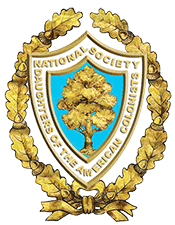History
North Carolina State Society
The organizational meeting of The Daughters of the American Colonists in North Carolina was held on on June 16, 1927, in the Virginia Dare Room, Sir Walter Raleigh Hotel, in Raleigh, NC. Fifteen ladies attended. The name chosen for the State Society was “Virginia Dare” in memory of the first child born of English parents on the American continent.
On December 2, 1927, the second meeting was held in the same place. Officers were elected, and delegates and alternates were elected to the General Assembly. The charter membership roll was closed with the first twenty-five members accepted by the National Society.
About ten years later the National Board requested that all states with one chapter discontinue the name of the chapter and adopt the name of the State Society. The Virginia Dare Chapter then became “The North Carolina State Society Daughters of the American Colonists”.
North Carolina Chapters
Augustine Washington II Chapter
Augustine Washington II Chapter began with Miss Ethel Bailey who would tell you she was “of the Atlanta Baileys.” In 1962, she was a home economics teacher in Haywood County-Canton High School. She was quite a character and left many colorful memories with her students.
She loved history of the families of the South and recounted many stories of the settling of the mountains of western North Carolina. She was an ardent proponent of historical societies. Her famous family Chocolate Silk Pie recipe was a closely guarded secret, except when she shared it with friends. When she was elected the State Regent for DAC, she decided that it was important to start a chapter in Haywood County.
Mrs. Flora Mae Ward, another colorful woman and devoted historian and relative, also decided that she wanted a chapter in Haywood county. Betty Terrell and her sister, Helen McCracken, with Flora Mae began recruiting members and filling out papers to form the new chapter.
As work to organize the chapter progressed, many relatives were discovered in the area. With much pomp and circumstance, the chapter was formed in 1972.
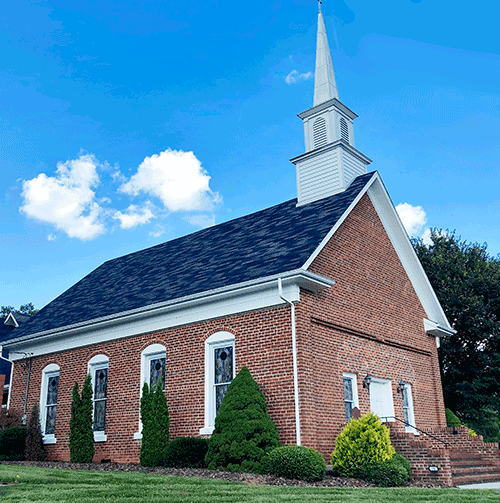
DAC dedicated a marker for The Mount Zion United Methodist Church in 2010, located at Crabtree, NC. Constructed in 1882-83, the brick church structure is the oldest remaining in use in Haywood County, and was listed on the National Register of Historic Places in 1986.
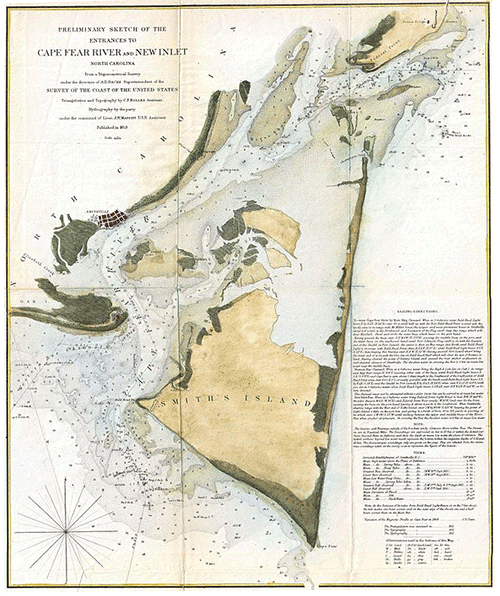
1853 U.S. Coast Survey map of the Cape Fear River.
The Cape Fear Chapter
Early in 2020, plans were started to organize a new chapter in the southeastern section of North Carolina. Pat Gooding was asked to be the Organizing Regent with assistance from Ruth-Anne Bolz. On October 5, 2020, the Cape Fear Chapter was approved.
Cape Fear, was adopted as the name of the Chapter as it is a prominent headland jutting into the Atlantic Ocean on the southeastern coast of North Carolina. It is largely formed of barrier beaches and the silty outwash of the Cape Fear River as it drains the southeast coast of North Carolina through an estuary south of Wilmington.
Carolina Charter Chapter
State Regent Mrs. Samuel H. Lee appointed Mrs. William L. Wyatt, Jr., of Raleigh, to be the Organizing Regent of the Carolina Charter Chapter. This was approved by the National Board in October of 1960. A preliminary organizational meeting was held in the home of Mrs. Wyatt on October 8, 1963. Both Mrs. Lee, then serving as National Vice-President of the Southern Section, and State Regent Mrs. Carl W. McMurray were guests. They spoke about the goals of the Daughters of the American Colonists and the duties of the officers and state chairmen. At this meeting it was decided to request National confirmation of the new chapter and to bring suggestions for a name to the meeting scheduled for January. The National Board gave its approval on October 16, 1963.
The formal organizational meeting was held in Raleigh on February 11, 1964, with the Organizing First Vice Regent Mrs. Roy H. Crowder presiding in the absence of the Organizing Regent Mrs. William L. Wyatt. Members from Admiral Anson, The Waxhaws, Unaka, Virginia Dare, and Wachovia Chapters were special guests.
Since the chapter was formed during the tercentenary of the Carolina Charter of 1663, it was decided that the chapter would be named the Carolina Charter Chapter.
The Carolina Charter of 1663 was given to the eight Lord Proprietors by King Charles II of England, who granted land to them in the colonies. North Carolina is one of only seven states to own its original, authentic colonial charter. It may be viewed at the North Carolina Museum of History in Raleigh. The National Board approved the name on April 13, 1964.
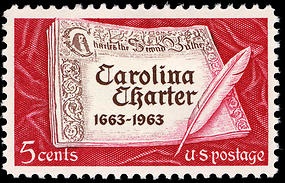
1963 Commemorative U.S. stamp.
John Lawson, Surveyor General Chapter
A meeting for the purpose of forming a new Daughters of the American Colonists chapter in Charlotte was held on November 26, 2001, at the Park Hotel. Fourteen prospective members and two current DAC members were present. State Regent Mrs. Gladys Kerr spoke about the purpose, goals, and objectives of the Society. She also discussed many of the rules and procedures of the organization. The Organizing Regent, Mrs. Ellen Hinson, told of plans for the proposed chapter. John Lawson, Surveyor General was the name chosen for the new chapter.
In early 1701, John Lawson made a 500-mile journey through the backcountry of the Carolinas, generally following the Indian Trading Paths. The journey began at Charlestowne (now Charleston, South Carolina), continued through what is now upstate South Carolina, entering what is now North Carolina just south of Charlotte and then continued east, ending at the Pamlico Sound. His diary became the most comprehensive description of the area for that time period.
A second organizational meeting of the new chapter was held on January 18, 2002. Eleven prospective members, two guests, and three current DAC members were present, including Mrs. Gladys Kerr. Prospective members brought their applications for review by Mrs. Hinson.
A meeting was held on February 26, 2002, with ten members in attendance. Also present at this meeting were Mrs. Gladys Kerr and Mrs. Mary Ann Hepler, DAC National President. Mrs. Hepler discussed membership, publications and insignias of DAC. At the next meeting which was held May 28, 2002, Mrs. Kerr presented membership certificates to all the members present and indicated that the certificates would be mailed to those not present. There were twenty-five organizing members.
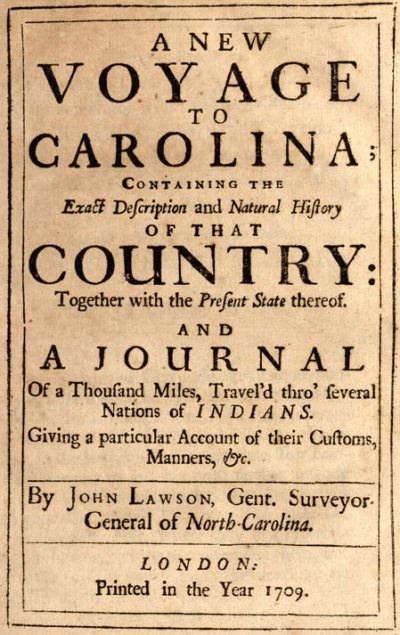
John Lawson played a major role in the founding of two of North Carolina’s earliest permanent European settlements: Bath and New Bern. On March 8, 1705, Bath was the first town incorporated in what was to become North Carolina.
In 1709, Lawson returned to London to oversee the publication of his book, A New Voyage to Carolina, in which he described the native inhabitants and the natural environment of the region.
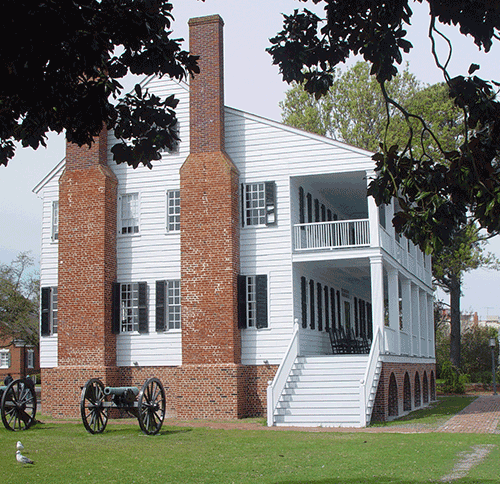
Penelope Barker house in Edenton, NC. Barker was known as a patriot of the American Revolution and ten months after the famous Boston Tea Party, she organized a Tea Party of her own. Penelope wrote a statement proposing a boycott on British goods. Followed by 50 other women, the Edenton Tea Party was created. On October 25, 1774, Barker and her supporters met at the house of Elizabeth King to sign the Edenton Tea Party resolution.
Penelope Barker Chapter
Lacking a DAC chapter in the northeastern area of North Carolina, State Regent Sarah Hepler Martin made it a priority of her administration to create a chapter for this region.
Working closely with her mother, Past National President Mary Ann Hepler, they approached Nell Dixon Garner of Greenville regarding organizing a new chapter “down east”. Being a former member of the disbanded Queen Anne Chapter in Kinston and a current member of the Carolina Charter Chapter, Ms. Garner was well acquainted with members in both areas.
After thoughtful discussion, Ms. Garner was appointed as Organizing Regent of a new chapter by State Regent Mrs. Martin. This was especially significant as Phyllis Best Jones from North Carolina was the presiding National President.
After contacting eligible friends and other chapter members in nearby towns, Mrs. Garner held an informational meeting on March 14, 2016, at the Immanuel Baptist Church, in Greenville, NC. Both State Regent Sarah Martin and Past National President Mary Ann Hepler were present. Also present were ladies from nearby Greenville, Winterville, Kingston, Goldsboro, Rocky Mount, and Edenton.
For the following year and a half, lineage papers were approved, and informal meetings were held during which bylaws were written and officers selected. The chapter was named after Edenton resident Penelope Barker who wrote the Edenton Proclamation in 1774. Penelope Barker is considered America’s first female activist.
On October 21, 2017, The Penelope Barker Chapter was officially recognized. Chapter officers were installed by National President Phyllis Best Jones at the State Assembly on October 27, 2017. The first organizational meeting was held in Greenville on January 30, 2018.
Unaka Chapter
The State Regent Mrs. Joseph A. Elliott appointed Mrs. R. N. Barber, Sr., as Organizing Regent of a Western North Carolina Chapter, Daughters of the American Colonists. Mrs. Barber called a preliminary meeting at her home on June 29, 1948. She invited ladies from Asheville, Brevard, Hendersonville, Marion, Waynesville, and Weaverville. Officers were elected at this meeting and the temporary name for the chapter was “The Western North Carolina Chapter of the Daughters of the American Colonists”. On December 15, 1948, the National Board accepted the chapter with the permanent name of Unaka.
On the same date as the chapter’s approval, Mrs. Barber hosted the organizational meeting of Unaka, where officers were installed and bylaws adopted. Mrs. Charles R. Whitaker, the State Organizing Regent in 1927, had transferred to the new chapter. Having accepted the position of chapter chaplain, she installed the new officers.
The chapter chose Unaka as its name, inspired by the nation’s newest national park, the Blue Ridge Parkway in the great Smoky Mountains. The Smoky Mountains were also known to the Indians as the Great White Mountains. The mountains were sacred to their history as the seat of their most ancient and revered god, Michabo, the Great White God, or God of Smoke. In the Cherokee language “Unaka” is the word for “white”.
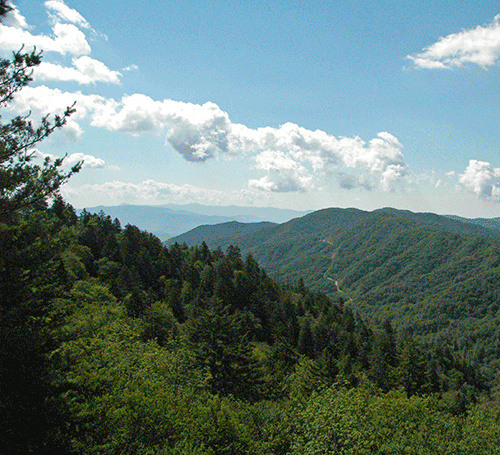
North Carolina Blue Ridge Mountains, Great Smoky Mountains National Park.
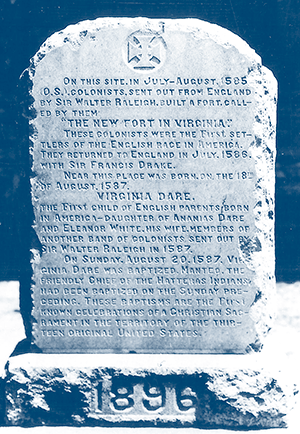
Monument to Virginia Dare and the Roanoke Colony. Virginia Dare — the first child of English parents born in the New World — was baptized August 20, 1587.
Virginia Dare Chapter
About ten years after the Virginia Dare Chapter was accepted into the National Society, the National Board requested that this chapter discontinue the chapter name and become the North Carolina State Society Daughters of the American Colonists. When this name change was completed, the name “Virginia Dare” was reserved for such time in the future that the Society should divide into chapters. The first chapter organized was to reclaim the name “Virginia Dare” and become Chapter #1.
In 1948 the State Regent, Mrs. Joseph A. Elliott, requested permission from the National President to hold a special meeting on January 18, 1949, for the purpose of organizing a new chapter in North Carolina. The meeting was held in the home of Mrs. E.M. Shelton in Statesville. During this meeting the Virginia Dare Chapter adopted its name and organized the chapter. All members of the State Society, other than those now in the Unaka Chapter, were charter members. Mrs. W. C. Tucker was elected Regent, and the State Regent installed the chapter officers.
Because the Virginia Dare Chapter had once been organized, this chapter was allowed to keep the original organizational date of June 16, 1927.
The Waxhaws Chapter
In January 1959, State Regent Mrs. Samuel H. Lee, appointed Golden Acorn State Chair, Mrs. Dwight M. Cook, Jr., to become the Organizing Regent for a new chapter in Monroe. Mrs. Lee had prepared the lineage papers for the majority of the 55 charter members.
The organizational meeting was a luncheon held in the home of Mrs. N. M. Redfern, on March 19, 1960. She was ably assisted by her two daughters, Mrs. R. E. Heath, Jr. and Miss Mayneill Redfern. The newly elected officers were installed by Mrs. Benjamin Wyche, Sr., Honorary State Regent and Honorary National Vice President. Mrs. J. H. Summerville of Charlotte, Vice Regent of the Virginia Dare Chapter and National Vice Chairman of the Southern Section’s Patriotic Education Committee, was also a guest.
The chapter name came from a tribe of Native Americans called the Waxhaws. They probably derived their name from the reed-like haws that were abundant along the banks of the Twelve Mile and Waxhaw Creeks which meander westward to the Catawba River. The haws were of a waxey substance, hence the name, Waxey-haws, which developed into “Waxhaw.” The Waxhaw tribe were almost wiped out in 1741 by smallpox so that the few remaining left the section to join a tribe of Indians near the Catawba River. Settlers traveled down the Great Wagon Road and founded the Waxhaw Settlement around 1751 often referring to the area as “Garden of the Waxhaws”.
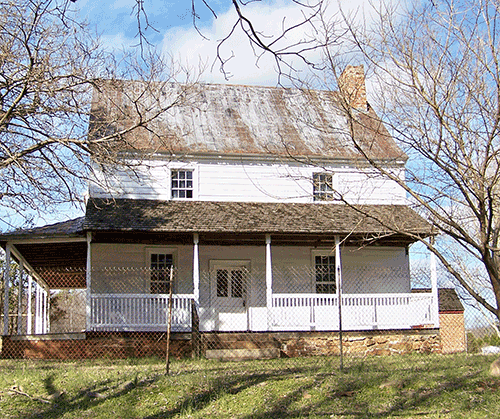
Hoyle Homestead originally built in the mid 1700s.
